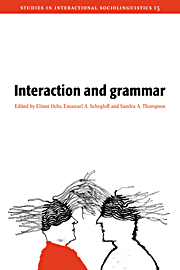Book contents
- Frontmatter
- Contents
- Notes on the contributors
- 1 Introduction
- 2 Turn organization: one intersection of grammar and interaction
- 3 Interactional units in conversation: syntactic, intonational, and pragmatic resources for the management of turns
- 4 Resources and repair: a cross-linguistic study of syntax and repair
- 5 On the “semi-permeable” character of grammatical units in conversation: conditional entry into the turn space of another speaker
- 6 On repeats and responses in Finnish conversations
- 7 “When I come down I'm in the domain state”: grammar and graphic representation in the interpretive activity of physicists
- 8 Transparent vision
- 9 Conversational signifying: grammar and indirectness among African American women
- 10 Creating evidence: making sense of written words in Bosavi
- Appendix Transcription conventions
- Index
2 - Turn organization: one intersection of grammar and interaction
Published online by Cambridge University Press: 14 January 2010
- Frontmatter
- Contents
- Notes on the contributors
- 1 Introduction
- 2 Turn organization: one intersection of grammar and interaction
- 3 Interactional units in conversation: syntactic, intonational, and pragmatic resources for the management of turns
- 4 Resources and repair: a cross-linguistic study of syntax and repair
- 5 On the “semi-permeable” character of grammatical units in conversation: conditional entry into the turn space of another speaker
- 6 On repeats and responses in Finnish conversations
- 7 “When I come down I'm in the domain state”: grammar and graphic representation in the interpretive activity of physicists
- 8 Transparent vision
- 9 Conversational signifying: grammar and indirectness among African American women
- 10 Creating evidence: making sense of written words in Bosavi
- Appendix Transcription conventions
- Index
Summary
Introduction
From early in its development, conversation-analytic work on interaction has declined to accord language any principled primacy as an object of inquiry (e.g., Schegloff and Sacks, 1973: 290). Although not derived from them, this view was in accord with the stances of such intellectual forbears as Garfinkel's ethnomethodology (1967) and Goffman's several approaches to interaction. It may be recalled, for example, that in “The neglected situation” Goffman (1964) injected into the “coming-out party” of the embryonic subfield known as the ethnography of speaking or communication the observation that speaking occurs most proximately in “situations,” in which it need not occur; speaking, then, had to be understood by reference to exigencies of contexts not designed for speaking in particular (as elaborated, for example, in the earlier Goffman, 1961, 1963, and the later Goffman, 1971). In both of these modalities of work, and in their predecessors, language was not a privileged object of inquiry, however interesting an object of inquiry it might be.
Still, the accessibility of conversation (and talk-in-interaction more generally) to systematic inquiry has brought with it a need to explore the mutual bearing of the various organizations of “language” on the one hand (whatever that notion might turn out to refer to; cf. Schegloff, 1979: 282) and the organizations of interaction and talking-in-interaction on the other. For linguistics, the promise has been to situate language relative to the social/interactional matrix in which it is to be understood as inescapably as it is relative to the organization of the mind/brain.
- Type
- Chapter
- Information
- Interaction and Grammar , pp. 52 - 133Publisher: Cambridge University PressPrint publication year: 1996
- 555
- Cited by

